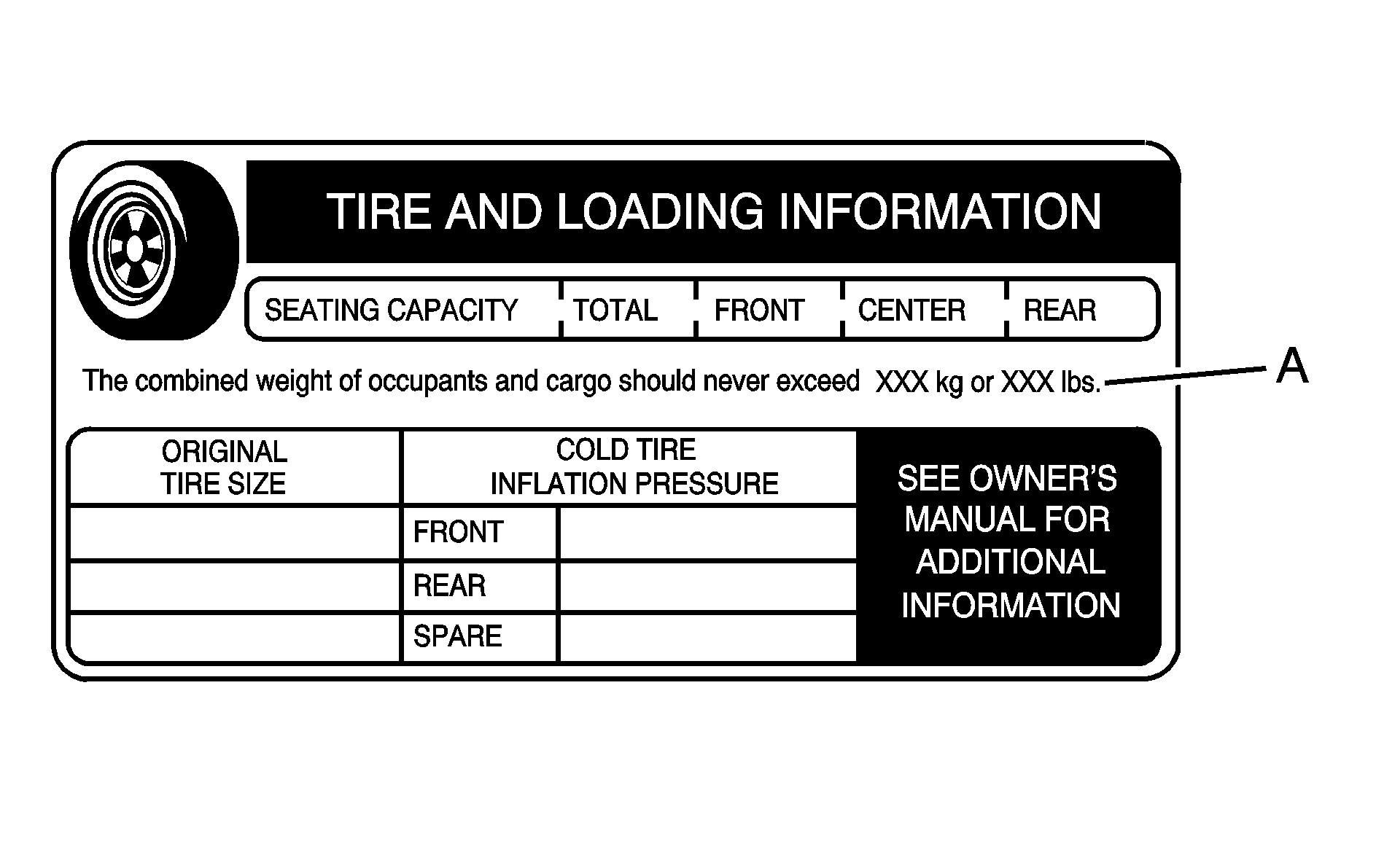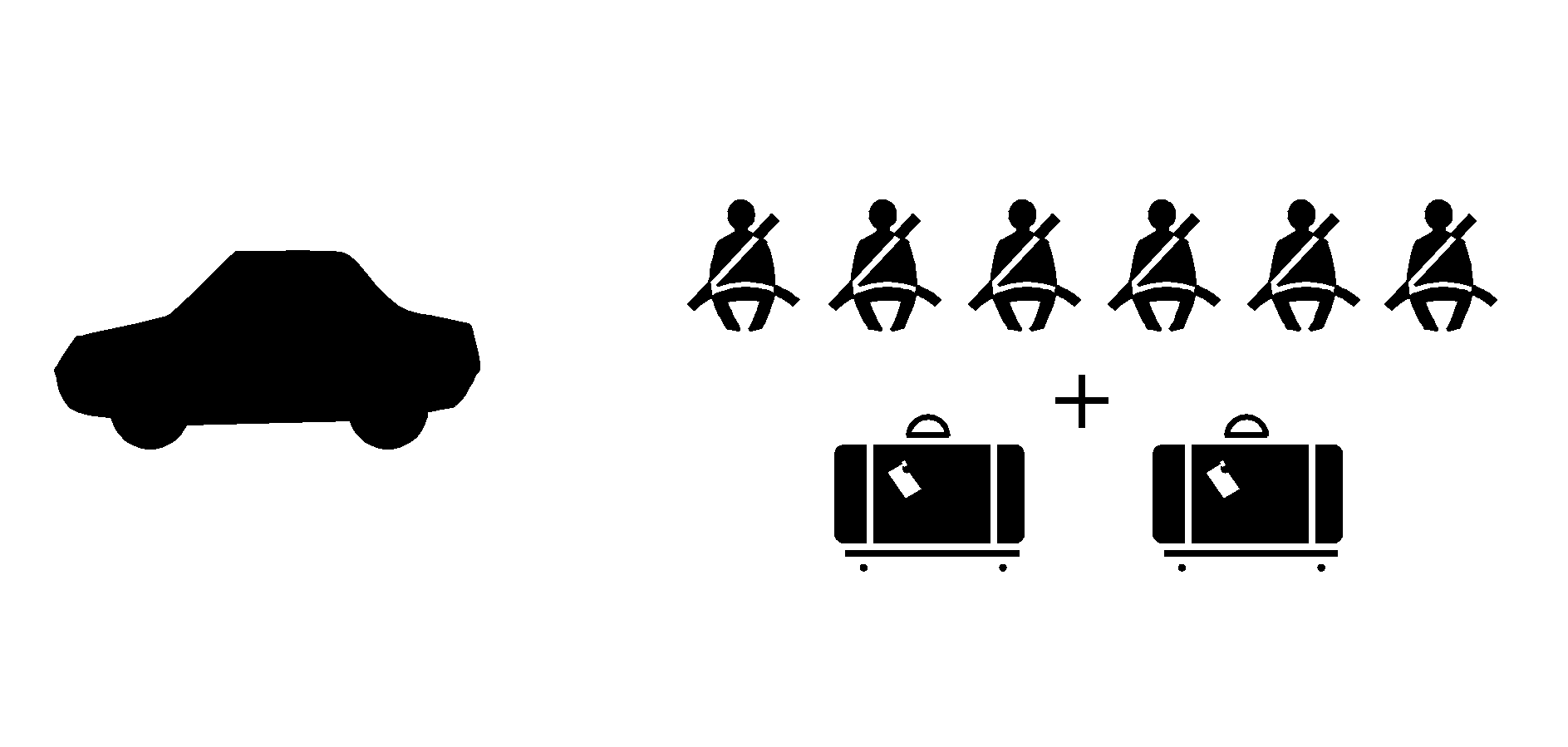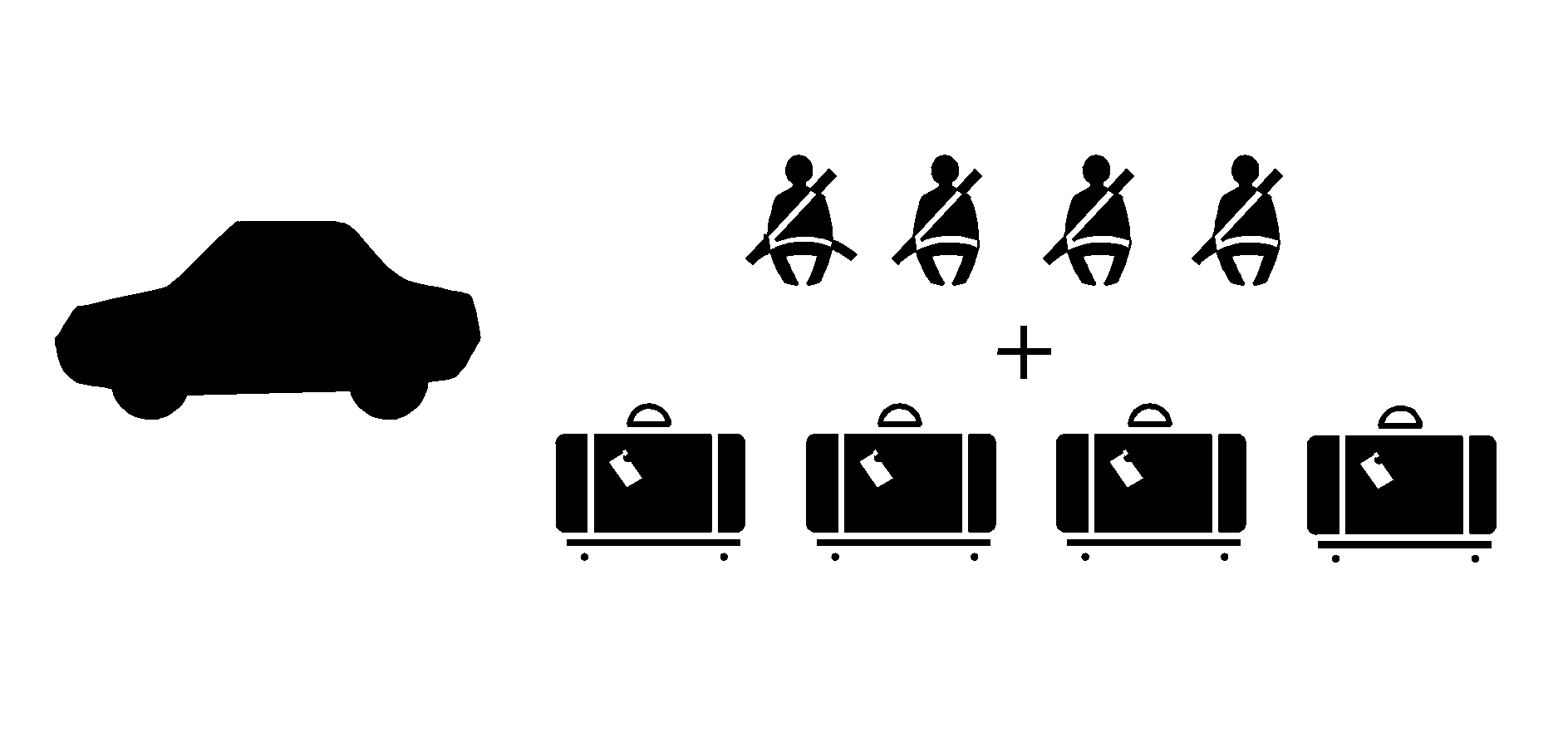It is very important to know how much weight your vehicle can carry. This weight is called the vehicle capacity weight and includes the weight of all occupants, cargo and all nonfactory-installed options. Two labels on your vehicle show how much weight it may properly carry, the Tire and Loading Information label and the Certification/Tire label.
Caution: Do not load the vehicle any heavier than the Gross Vehicle Weight Rating (GVWR), or either the maximum front or rear Gross Axle Weight Rating (GAWR). If you do, parts on the vehicle can break, and it can change the way your vehicle handles. These could cause you to lose control and crash. Also, overloading can shorten the life of the vehicle.
Tire and Loading Information Label

Vehicle Capacity Weight
The Tire and Loading Information label is attached to the center pillar, near the driver's door latch. Vehicles without a center pillar will have the Tire and Loading Information label attached to the driver's door edge. This label lists the number of people that can be in your vehicle and the total weight it can carry. This weight is called the vehicle capacity weight.
The Tire and Loading Information label also tells you the size and recommended inflation pressure for the original equipment tires on your vehicle. For more information on tires and inflation see Tires and Inflation - Tire Pressure .
If your vehicle does not have the Tire and Loading Information label, the Certification/Tire label shows the tire size and recommended inflation pressures needed to obtain the Gross Vehicle Weight Rating (GVWR) and the Gross Axle Weight Rating (GAWR) for the front and rear axles. See "Certification/Tire Label" later in this section.
Steps for Determining Correct Load Limit
- Locate the statement "The combined weight of occupants and cargo should never exceed XXX pounds" on your vehicle placard.
- Determine the combined weight of the driver and passengers that will be riding in your vehicle.
- Subtract the combined weight of the driver and passengers from XXX kilograms or XXX pounds.
- The resulting figure equals the available amount of cargo and luggage load capacity. For example, if the "XXX" amount equals 1400 lbs. and there will be five 150 lb. passengers in your vehicle, the amount of available cargo and luggage load capacity is 650 lbs. (1400 - 750 (5 x 150) = 650 lbs.).
- Determine the combined weight of luggage and cargo being loaded on the vehicle. That weight may not safely exceed the available cargo and luggage load capacity calculated in Step 4.
- If your vehicle will be towing a trailer, the load from your trailer will be transferred to your vehicle.
Example 1

Item | Description | Total |
|---|---|---|
A | . Vehicle Capacity Weight = | 1,076 lbs (488 kg) |
B | Passenger Weight @ 167 lbs (76 kg) × 6 = | 1,002 lbs (454 kg) |
C | Cargo Weight @ 37 lbs (17 kg) × 2 = | 74 lbs. (34 kg) |
A - (B + C) = | 0 lbs (0 kg) |
Example 2

Item | Description | Total |
|---|---|---|
A | Vehicle Capacity Weight = | 1,076 lbs (488 kg) |
B | Passenger Weight @ 225 lbs (102 kg) × 4 = | 900 lbs (408 kg) |
C | Cargo Weight @ 44 lbs (20 kg) × 4 = | 176 lbs. (80 kg) |
A - (B + C) = | 0 lbs (0 kg) |
Example 3

Item | Description | Total |
|---|---|---|
A | Vehicle Capacity Weight = | 1,076 lbs (488 kg) |
B | Passenger Weight @ 200 lbs (91 kg) × 3 = | 600 lbs (272 kg) |
C | Cargo Weight @ 44 lbs (20 kg) × 6 = | 264 lbs. (120 kg) |
A - (B + C) = | 212 lbs (96 kg) |
The Tire and Loading Information label gives you specific information about your vehicle's capacity weight and seating positions. Examples 1, 2, and 3 show how driver and passenger weight, and cargo weight can vary and still be equal to or under the vehicle capacity weight. These examples show how seating positions occupied by heavier passengers leaves less vehicle capacity weight available for cargo. The combined weight of the driver, passengers and cargo should never exceed your vehicle's capacity weight. Also see Towing a Trailer .
Certification/Tire Label

The Certification/Tire label is found on the driver's door edge, above the door latch. The label shows the size of your original tires and the inflation pressures needed to obtain the gross weight capacity of your vehicle. This is called the Gross Vehicle Weight Rating (GVWR). The GVWR includes the weight of the vehicle, all occupants, fuel, cargo and trailer tongue weight, if pulling a trailer.
The Certification/Tire label also tells you the maximum weights for the front and rear axles, called Gross Axle Weight Rating (GAWR). To find out the actual loads on your front and rear axles, you need to go to a weigh station and weigh your vehicle. Your dealer can help you with this. Be sure to spread out your load equally on both sides of the centerline.
Never exceed the GVWR for your vehicle, or the GAWR for either the front or rear axle.
If you do have a heavy load, you should spread it out.
Similar appearing vehicles may have different GVWRs and payloads. Please note your vehicle's Certification/Tire label or consult your dealer for additional details.
Caution: Do not load the vehicle any heavier than the Gross Vehicle Weight Rating (GVWR), or either the maximum front or rear Gross Axle Weight Rating (GAWR). If you do, parts on the vehicle can break, and it can change the way your vehicle handles. These could cause you to lose control and crash. Also, overloading can shorten the life of the vehicle.
Using heavier suspension components to get added durability might not change your weight ratings. Ask your dealer to help you load your vehicle the right way.
Notice: Overloading your vehicle may cause damage. Repairs would not be covered by your warranty. Do not overload your vehicle.
If you put things inside your vehicle-like suitcases, tools, packages, or anything else-they will go as fast as the vehicle goes. If you have to stop or turn quickly, or if there is a crash, they'll keep going.
Caution: Things you put inside your
vehicle can strike and injure people in a sudden stop or turn, or in a crash.
• Put things in the cargo area of your vehicle. Try
to spread the weight evenly. • Never stack heavier things, like suitcases, inside
the vehicle so that some of them are above the tops of the seats. • Do not leave an unsecured child restraint in your
vehicle. • When you carry something inside the vehicle, secure
it whenever you can. • Do not leave a seat folded down unless
you need to.
There's also important loading information for off-road driving in this manual. See "Loading Your Vehicle for Off-Road Driving" under Off-Road Driving with Your Four-Wheel-Drive Vehicle .
Payload
This is the maximum load capacity that your vehicle can carry. Be sure to include the weight of the occupants as part of your load. If you added any accessories or equipment after your vehicle left the factory, remember to subtract the weight of these things from the payload. Your dealer can help you with this.
Add-On Equipment
When you carry removable items, you may need to put a limit on how many people you carry inside your vehicle. Be sure to weigh your vehicle before you buy and install the new equipment.
Notice: Overloading your vehicle may cause damage. Repairs would not be covered by your warranty. Do not overload your vehicle.
